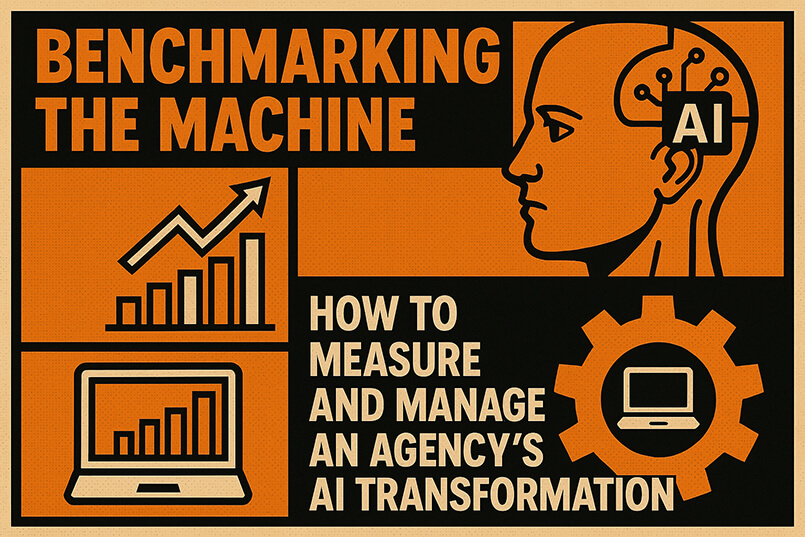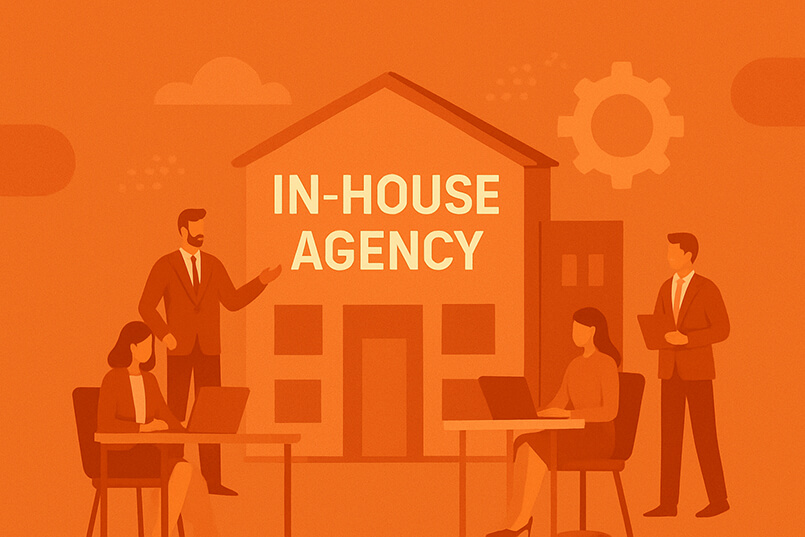The marketer’s dilemma today is not whether their media agency uses Artificial Intelligence, but how effectively they use it.
Every holding company and independent agency now boasts “AI-powered solutions” and “GenAI integration,” but for the Chief Marketing Officer (CMO) signing the cheques, these claims can feel frustratingly opaque. The actual value of AI lies not just in automation, but in measurable improvements to the core tenets of marketing delivery: productivity, quality and performance, speed to market, and scalability.
How do marketers move beyond the buzzwords and benchmark their agency’s AI transformation to ensure they are getting a tangible return on innovation? This 1,500-word guide breaks down the challenges, outlines a best-practice methodology, and specifies the metrics you should demand from your agency partners across these four critical criteria.
The AI Value Gap: Challenges in Benchmarking
Before implementing any metric, it is vital to understand the fundamental problems that prevent easy measurement of AI success in an agency environment:
The ‘Black Box’ Problem
AI models, including large language models (LLMs) used for creative and strategic tasks, are inherently opaque. It is difficult to directly attribute specific outcomes, such as a 5% rise in conversion rates, to the AI intervention rather than to human strategies or external market factors. Agencies often keep their proprietary AI tools hidden, which makes external auditing challenging.
The ‘Denominator’ Challenge (Productivity)
Productivity is traditionally measured as Output divided by Input. With AI, the Input (human labour) changes dramatically. If an AI produces 100 ad headlines in 10 minutes that a human previously took two hours to craft, the human input cost decreases, but the accurate measure of productivity must include the time spent refining the AI’s output (prompt engineering, quality assurance). Are you measuring the speed of creation or the speed of deployable, quality output?
The ‘Vanity Metric’ Trap (Quality)
Agencies are often tempted to gauge AI output through easily inflated internal metrics, such as “number of assets created.” This is a vanity metric. If the AI produces 500 display ads, but only 10% outperform the human-generated control group, the initiative has failed in terms of quality. Measurement must link AI directly to client business outcomes.
Best Practice Methodology: The AI Transformation Scorecard
To address these challenges, marketers need to insist on a structured, continuous review of AI deployment. The best approach is to establish an AI Transformation Scorecard following this framework:
| Criterion | What it Measures | Key Challenge | Best Practice Metric |
| Productivity | Efficiency of human capital and resource reallocation. | Accounting for human review/refinement time. | Cost per Deployable Asset (CPDA) |
| Quality & Performance | Business impact and measurable superiority of AI-driven work. | Attribution bias and reliance on internal metrics. | AI-Driven Incrementality Score (ADIS) |
| Speed to Market | The compression of campaign development cycles. | Focusing on total cycle time, not just asset creation time. | Time-to-Pilot (TTP) |
| Scalability | Ability to handle increased client volume without proportional cost. | Ensuring the tool works across various channels/clients. | Variable Cost Percentage Change |
Benchmarking Criteria and Key Metrics
Productivity Improvement: Productivity is the most immediate benefit promised by AI. The benchmark here is about efficiency improvements that enable human experts to concentrate on higher-value, strategic tasks.
Metric: Cost per Deployable Asset (CPDA)
- Formula: (Total Labour Cost (Human + AI Tooling) + Licensing Fees) / Number of Approved, Live
- Benchmark Goal: Aim for a 30% reduction in CPDA for asset-heavy activities (such as social ad variants and email subject lines) within the first 12 months. This metric accurately combines the costs of both the human (the prompt engineer and reviewer) and the machine, focusing solely on assets considered suitable for client use.
Metric: Human Reallocation Index (HRI)
- Formula: Percentage of FTE hours moved from repetitive tasks (e.g., reporting, resizing, bulk creative generation) to client strategy, insight mining, and innovation projects.
- Benchmark Goal: Demand a documented shift of 15% of media planning and creative production hours into strategic roles by the end of the first year. This demonstrates AI is creating capacity, not just removing busywork.
- Quality and Performance: The main goal of agency work is to achieve better business outcomes. AI shouldn’t just speed up processes; it should improve them.
Metric: AI-Driven Incrementality Score (ADIS)
- Methodology: This involves compulsory A/B testing where the AI-generated element (such as a landing page, a bid strategy, or a creative) is directly compared to the best human-only effort.
- Benchmark Goal: AI-driven assets must deliver a statistically significant lift (e.g., 5-10% improvement in CTR, CPA, CVR, or LTV) compared to the human control group in at least 60% of test cases. This is the accurate measure of quality.
Metric: Error Reduction Rate (ERR)
- Measurement: Monitor the decrease in errors identified by humans and the need for manual revisions in areas mainly using AI (e.g., data entry into trading platforms, budget pacing, localisation text errors).
- Benchmark Goal: Aim for a 75% reduction in compliance or mechanical errors within automated workflows (essential for regulatory compliance and brand safety).
- Speed to Market: In a rapidly changing market, being the first to deliver contextually relevant creative or to quickly adjust a media plan offers a competitive edge.
Metric: Time-to-Pilot (TTP)
- Measurement: The time from when a marketing brief is approved to the first live, measurable test impression of the AI-generated elements.
- Benchmark Goal: Agencies should aim for a 50% reduction in the TTP for large-scale creative variant generation, decreasing the time from weeks to days, or even hours, for specific campaign types (e.g., programmatic display refreshes).
Metric: Real-Time Optimisation Latency (RTOL)
- Measurement: The time it takes for the AI bidding or creative system to identify a statistically significant campaign anomaly and automatically take corrective action (e.g., pausing a poor-performing placement, shifting budget to a better-performing audience segment).
- Benchmark Goal: AI-driven optimisation actions should achieve an RTOL of under 30 minutes, markedly quicker than human-in-the-loop processes, which often take hours or days.
- Scalability: Scalability shows if the AI investment is future-proof and can manage your business’s growth or market expansion without escalating costs.
Metric: Variable Cost Percentage Change
- Measurement: Assess the change in overall production/media management costs (labour + tooling) required to support a fixed percentage rise in client output volume (for example, a 25% increase in media spend or audiences targeted).
- Benchmark Goal: The agency should be capable of handling a 25% increase in client volume with less than a 5% rise in variable costs. If the AI truly scales, the human labour needed to support that growth should be minimal.
Metric: Cross-Channel/Client Deployment Rate (CCDR)
- Measurement: The percentage of AI solutions (e.g., a custom LLM fine-tuned for your brand voice) that are successfully deployed and delivering measurable results across three or more different media channels, such as Search, Social, or Programmatic Display, or across different client brands or product lines.
- Benchmark Goal: Require that core AI models achieve a high CCDR (over 80% deployment success) to demonstrate the agency’s ability to develop platform-agnostic, enterprise-level solutions rather than isolated pilot projects.
Common Problems and Accountability
To succeed, marketers must hold the agency responsible for certain issues:
| Problem | Accountability Area | Best Practice Solution |
| Data Silos | AI training is isolated, limiting learning. | Demand a Unified Data Strategy where AI models train on anonymized, pooled performance data across clients (with permission) to accelerate insight generation. |
| Skill Gaps | Agency staff lack the expertise to prompt, audit, or refine AI output. | Require the agency to provide a Certification Register showing the number of employees formally trained and certified in AI model management and prompt engineering. |
| Attribution Wars | Internal arguments over whether AI or human talent gets credit for success. | Mandate the ADIS (AI-Driven Incrementality Score) as the single source of truth for all AI-assisted campaigns. |
| AI Drift | AI performance degrades over time due to poor data or lack of retraining. | Require documented, mandatory Quarterly Model Refresh cycles to retrain and fine-tune proprietary AI tools. |
The Mandate for Measurement
AI transformation represents the most important structural change in the agency sector since the emergence of programmatic buying. It requires an investment that delivers a business-level return.
As a marketer, your duty is to challenge vague promises of “innovation.” By using the AI Transformation Scorecard and focusing on concrete metrics like CPDA, ADIS, TTP, and Variable Cost Change, you push the agency to demonstrate that their investment in the machine directly leads to a better, more efficient, and faster service for your brand. This isn’t just about saving money; it’s about gaining the competitive edge needed to succeed in a highly efficient, AI-driven market. The era of soft metrics has passed, it’s time to benchmark the machine.
You can read more on our Agency Operational Reviews here or contact us for a confidential discussion on how we can benchmark your agencies’ AI transformation and delivery.




